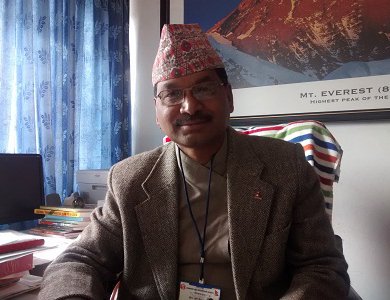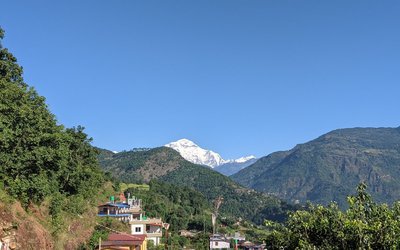
How do you describe the present state of tourism in Nepal?
The present state is very satisfactory. Tourism is moving on the right direction. This is a golden period of the sector.
How do you view the year 2015 compared to 2014 in that respect?
The year 2014 was a springboard for us. The tourism sector performed well in that year. Although there were certain disputes in Nepal Tourism Board in 2014, the progress was encouraging as the number of tourists continues to grow. We might be unable to meet the target. However, one of the major achievements of the year was the announcement of the construction of Gautam Buddha International Airport in Bhairahawa. Similarly, a decision was also taken to construct a regional airport in Pokhara. Both the decisions will bring a drastic change in Nepal’s tourism sector.
What about the outlook for the year 2015?
This year will be historic in many senses. Foundation stone will be laid for Nepal’s second international airport this year. We are expecting that the constitution of Gautam Buddha International Airport will be completed by the end of 2017. After the completion of this airport, Nepal’s air connectivity will increase to meet the target of bringing one million tourists. In this sense, 2014 was a milestone and 2015 is going to be a major year.
When will the constructions of Gautam Buddha Airport start?
Prime Minister Sushil Koirala is scheduled to lay down the stone of the Gautam Buddha International Airport on January 15, 2015. The expansion of the airport will complete by two years from the construction period, that is, by December 2017. Sri Lanka has already assured us that there will be charter flights from Colombo. We have been implementing Tribhuwan International Airport Improvement Project. There have been certain obstructions initially but the project will complete in time.
How do you see opportunities in Nepal’s tourism sector?
Nepal's tourism sector has great possibilities. We have many things to lure the tourists. Along with bringing tourists, we also need to have hotels for them. There are a number of four and five star hotels coming up.
What about Pokhara Regional Airport?
The construction of Pokhara Regional Airport will start shortly. Some groups are reportedly creating obstructions in the name of compensation. I don’t think it will halt the process of construction. We are working to lay down the stone for Pokhara Regional Airport.
At a time when the Tribhuwan International Airport, the only international airport in the country, is said to be in saturation, how do you see the recent ASA between Nepal and Oman will play out?
You are right-- the Tribhuwan International Airport has reached a saturation point. However, the Tribhuwan International Airport Improvement project is currently going on to ease the saturation. The airport is operating 18 hours a day.
How do you view the recent ASA with Oman?
We have signed Air Service Agreement (ASA) to provide 21 flights a week to Oman. It will take almost two to three years to implement it. Nepal made initial accord with Oman in 1997 but the ASA was implemented in 2010 only. Oman is operating seven flights a week now and Nepal is yet to make benefit out of this. As TIA’s capacity improvement work is going on, the overall capacity of the airport will go up following the completion of the project.
How will it benefit?
As Nepal Airlines will have two new Airbuses soon, it will require additional routes to fly. Since Oman is in the center of Gulf, we can use Oman as a transit to fly to Saudi Arabia, Kuwait and other countries in Gulf. With over a million Nepalese in the Gulf countries, Nepal needs more flights. There is a high demand now for Dubai and Qatar. The increased flight operation to Oman will drastically reduce the pressure in these two countries. There are a lot of benefits for Nepal.
How do you see the importance of internal tourism?
We are now allocating NTB’s budget to promote tourism in Nepal. Internal tourism can play an important role in any part of the world. Thus, we are also promoting internal tourism. For instance, internal tourism is playing an important role in Pokhara and over 50 percent of the rooms in Pokhara are occupied by Nepalese tourists.
As you mentioned, Tribhuwan International Airport remains idle for six hours, don’t you have any plan to make it operational 24 hours a day?
We are also working on how to utilize the remaining six hours. During the period of SAARC summit, we tried to use the off-hours after mid-night. This gave a good result. Since TIA has only one runway, there is the need to allocate certain hours for its repair. After the completion of the improvement project, we will have more options to operate the airport round the clock. Of course, there will be only one for landing and that is from the southern side. After the completion of the improvement project, there will be a parking bay and other space which will reduce the pressure on the runway. It will increase the capacity of the airport.
Do you have any plan to relocate the domestic airport?
We are now considering relocating the domestic airport from the current site by making the airport only for international flights. We are looking for land in Kavre. If we remove the domestic airport to Kavre, it will reduce the pressure on the international airport. Given the present scenario, the number of tourists will increase from the current number of 800,000 to a million tourists.
As Nepal has been selling the same destinations for a long time, do you have any plan to identify new destinations?
We are aware about the situation. Nepal is now working to open new destinations in different parts of the country. There are many virgin areas which are yet to be explored. For instance, there is a huge potential for Rara Lake to be used as major tourist attraction.
How do you see the role of NTB?
We have to accept the fact that Nepal Tourism Board (NTB) failed to work as per the expectation in the year 2014 and it was unable to identify new destinations. Now everything is settled in NTB and it will start its functions properly to identify new destinations for tourists. Even the Public Accounts Committee of the Legislature Parliament directed us to make broader plans for tourism promotion and development. NTB is an apex body for the promotion of tourism in Nepal and the Ministry of Culture Tourism and Civil Aviation is another such body. Recently, we have made the budget and programs of NTB for promoting internal tourism.
What are your general views on tourism?
We have certain misconceptions about tourism. Our definition of tourism is based on those who come to visit Nepal by taking the plane route. This is a wrong perception. There is no place for internal tourism in our plan. In USA, China and India, internal tourism is more important. Over fifty percent of hotels are occupied by internal tourists.
What plans do you have to promote internal tourism?
We are now working to develop destinations looking at the flow of internal tourists. We are now promoting home stay programs in many places. We have just opened Kaulepani of Lamjung district. Similarly, we have opened three villages in Dhading district and one in Tanahu. There is a demand from Ilam and Syangja. We have opened new trekking trails.
As a number of tourists died last October due to snow storms, what plans do you have to prevent such disasters in the future?
Due to Hud Hud, there was a casualty in Annapurna region. We are now working to improve the communication channels to prevent such incidents in the future. NTB is now building shelter houses, coffee houses and toilets in various trekking trails. Just recently, there were huge snowfalls in Manang and Mustang districts. Many tourists are now in our sheds.
As Nepal Airlines is receiving its first Aircraft within two months, how will this contribute to tourism?
Of course, the national flag carrier can play a very important role in promoting tourism. After almost two decades, Nepal Airlines is receiving two jets from Airbus for international flights. The People's Republic of China has already provided M 60 and Y12E aircraft. This will enhance the capacity of Nepal Airlines. After February, Nepal Airlines will come to occupy its previous position with two new Airbuses. I am happy that NAC is receiving the aircraft on scheduled time.
Don’t you think this is important?
Without identifying new destinations, we cannot increase the stay of tourists in Nepal and without increasing their stay, we cannot increase the income.
What about religious tourism?
Nepal has many important religious places which are sacred for both Hindus and Buddhists. Large numbers of Indian tourists have been visiting different religious sites of Nepal. Along with Pashupatinath, a number of Indian tourists are visiting Muktinath and this number has gone up drastically. Similarly, Indian tourists visiting Janakpurdham has also increased. Likewise, there is an immense possibility to tap religious tourists from Buddhist countries. After the completion of the Gautam Buddha International Airport at Bhairahawa, more tourists are expected in Nepal. Sri Lanka has already promised to bring at least one charter flight a day in Lumbini following the completion of the airport.
- TANAHU HYDROPOWER PROEJCT: A Significant Achievement
- Apr 15, 2024
- AMBASSADOR HANAN GODAR: Sharing Pain With A Nepali Family
- Mar 30, 2024
- VISIT OF KfW AND EIB TO NEPAL : Mission Matters
- Mar 25, 2024
- NEPAL BRITAIN SOCIETY: Pratima Pande's Leadership
- Mar 24, 2024
- NEPAL ARMY DAY: Time To Recall Glory
- Mar 15, 2024















